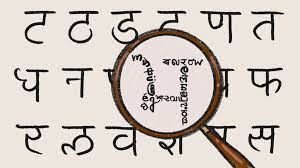Murchana Goswami
Sanskrit, which is hailed as the oldest language in India, holds a significant position in the country’s cultural and linguistic heritage. Often referred as the “language of the gods”, Sanskrit remains to be the most sacred language in the world. Its roots can be traced back to the Vedic period, where Rigveda is considered to be the earliest known text in Sanskrit. But, despite its historical and cultural significance, Sanskrit is considered to be a dead language today. In the entire country, less than 25,000 people call Sanskrit their mother tongue.
There was a time where Sanskrit was one of the most widely spoken languages in India. But today, there are hardly any people who can speak this language as fluently. What’s even hard to comprehend is that, despite its historical importance, Sanskrit has been a difficult subject to teach in schools. And as a result, its curricular integration has not been entirely effective. Students still struggle to learn the language completely, despite it benig taught in schools. But why is that so?

Now, there are several reasons why students face challenges in fully grasping the language. One might argue the relevance of Sanskrit in today’s age of science and technology. Others might look at it only as a language of religion or prayers. But the truth is, Sanskrit is not just a language of religion or prayers but it’s a language in which every subject known to man was written. For example, there is Grisha Shastra for agriculture, Rasayana for horticulture, Shastra for chemistry, Loja Shastra for metallurgy, and the list goes on. In fact, Sanskrit has more non-religious scientific literature than texts on religious subjects.
Another reason why students find it difficult to use Sanskrit in their day-to-day lives is because they feel Sanskrit is a difficult language. And what adds more to this difficulty is that in Sanskrit, there are many words for a single object while English uses only one word. In that case, one might wonder why Sanskrit uses so many words for a single object. Is it to create difficulty for learning the language?
The answer to this question is, Sanskrit is not an object specific language, it’s a context specific language and a property-based language. Sanskrit describes the properties of a particular object. And this is what adds to the richness of this language.
But, in today’s fast changing world, where international languages predominate in communication, the use of Sanskrit in day-to-day lives seems almost impossible. It becomes difficult for students to relate to a language that seems distant from their everyday experiences and prospective employment opportunities.
Moreover, India is a diverse country where every state or region has their own language. The tribal areas in the Northeast still find it difficult to adapt to Hindi. As their mother tongue is different, they face enormous trouble coping with the teaching and learning of Hindi. In such a scenario, the use of Sanskrit is understandably less.
Another major obstacle to successful learning of Sanskrit might be to not know the script or pronunciation properly. The structure and writing of Sanskrit differs greatly from the languages that are regularly spoken in India. Due to this linguistic gap, students face trouble in understanding the little nuances of the language’s vocabulary and grammar.

Furthermore, the effectiveness of any language program is greatly dependent on the teaching style. The current, interactive language system that is being used today may not be compatible with the traditional ways of Sanskrit training. The rote learning method of studying Sanskrit deters the students and makes it difficult for them to interact meaningfully with the language. That’s why, despite its inclusion in the educational curriculum, the use of Sanskrit in our everyday lives is ineffective.
However, attempts are being made to revive interest in this language. There are various institutes which are offering courses on Sanskrit to attract students in learning the language. And initiatives are being taken to digitalize Sanskrit works so that they may be more accessible to a wider audience.
Thus, Sanskrit remains to be a priceless gem due to its historical significance, cultural diversity and linguistic richness. The language still inspires a lot of academicians and linguists around the globe, despite the difficulty it faces in contemporary teaching and learning. Therefore, it is essential to make efforts to learn, preserve and promote Sanskrit in order to explore India’s cultural heritage and to recognize the timeless value of this age-old language.
